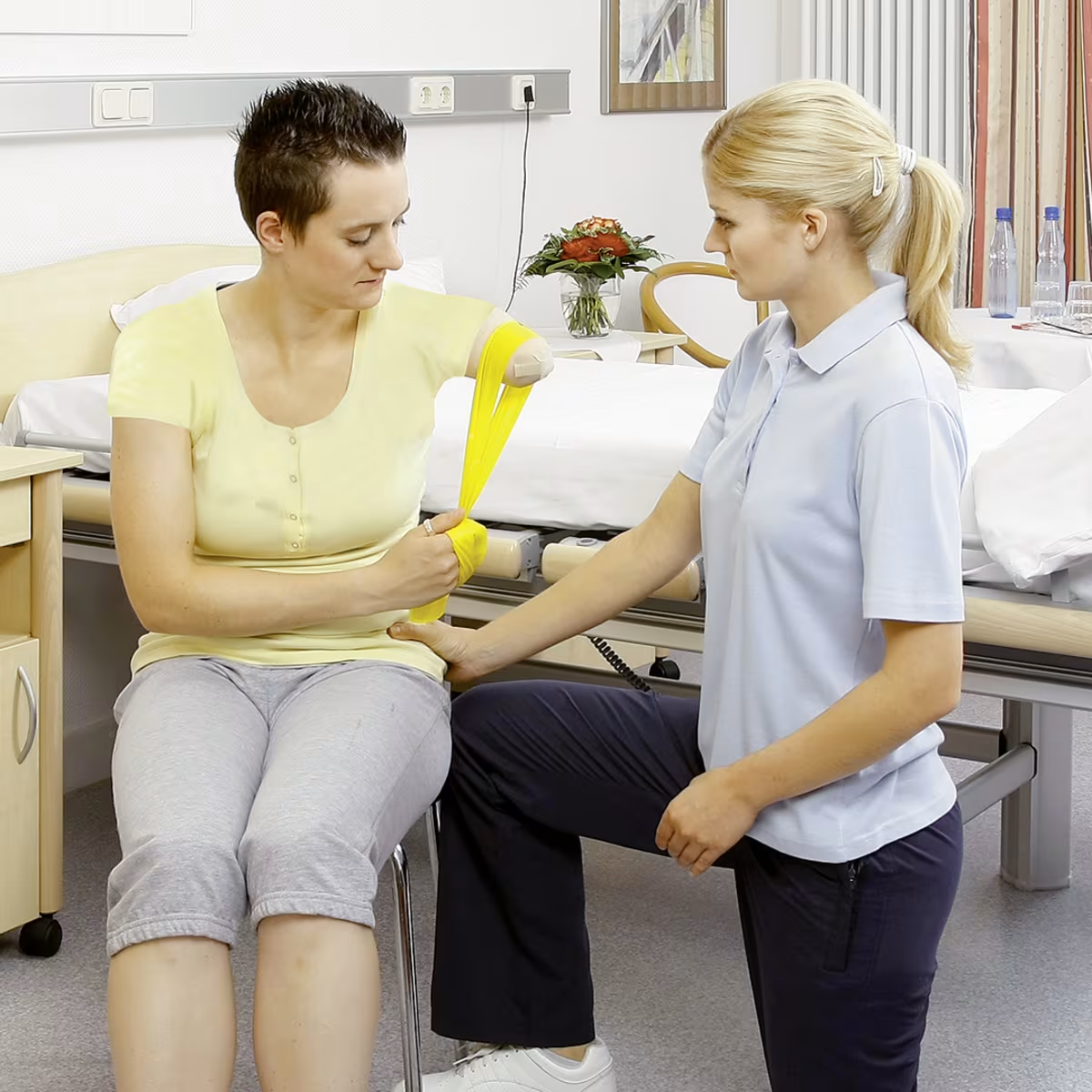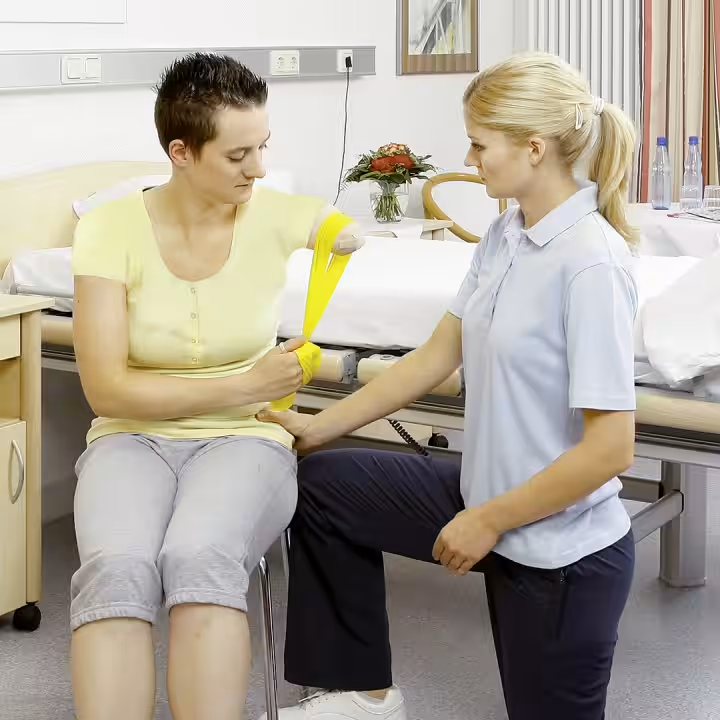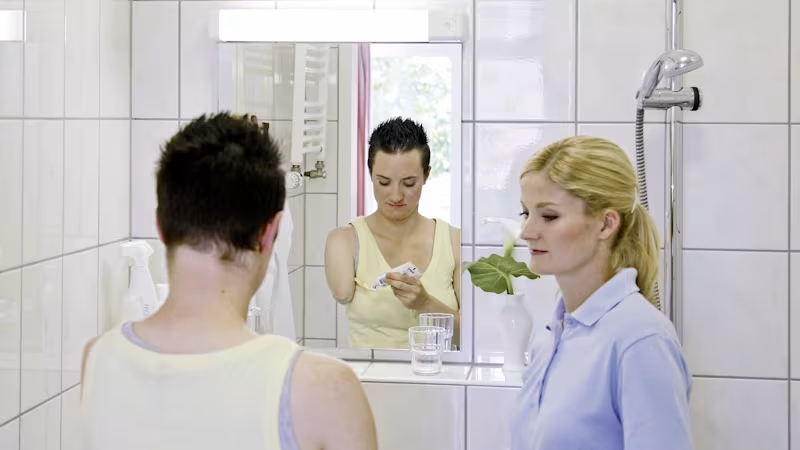


Nakon amputacije gornjih ekstremiteta
Nakon amputacije gornjih ekstremiteta, vaš oporavak i zacjeljivanje bataljka glavna su briga. Ovdje možete pronaći savjete za terapiju, trening i njegu bataljka.
Nakon amputacije gornjih ekstremiteta, vaš oporavak i zacjeljivanje bataljka glavna su briga. Ovdje možete pronaći savjete za terapiju, trening i njegu bataljka.
Što vas čeka nakon amputacije?
Nakon amputacije, na vaš bataljak postavljaju se posebne obloge za zacjeljivanje rana (ili zavoji). Glavni cilj je brzo zacjeljivanje kirurške rane i pripremanje bataljka za vašu buduću protezu.
Prva faza koja slijedi odmah nakon operacije usredotočena je na tri cilja liječenja: trebali biste osjećati što je moguće manje boli, vaš bataljak mora biti u mogućnosti nositi težinu te biste trebali postići optimalnu pokretljivost bataljka u svim smjerovima.
Kako biste postigli sve navedeno, nužno je da vam vaš liječnik ili fizioterapeut pokaže neke važne stvari neposredno nakon operacije: pravilno pozicioniranje u krevetu kako se mišići i zglob koji je najbliži bataljku ne bi skratili ili ukočili, vježbe pravilnog disanja i lagane vježbe kretanja i mobilnosti. Ovim mjerama se pomaže osigurati da brzo i bez poteškoća budete opskrbljeni protezom kako biste mogli ostati mobilni i aktivni.
Zacjeljivanje rane bataljka
Nakon što se probudite iz anestezije, na vašoj će ruci već biti postavljena obloga koja se sastoji od jednostavnih zavoja ili gips iz kojeg izlazi mala cjevčica. Ova cjevčica je umetnuta u ranu za vrijeme zahvata kako bi se iscijedila tekućina i krv iz rane. Poznata kao dren, ova cjevčica se uklanja unutar razdoblja zacjeljivanja rane.
U većini slučajeva rana nastala amputacijom zatvori se unutar prva tri do četiri tjedna te nastaje ožiljak. Međutim, čak i ako ožiljak izvana izgleda kao da je dobro zacijelio, te se od tog trenutka neznatno mijenja samo boja ožiljkastog tkiva, cjelokupni proces zacjeljivanja ožiljka traje puno duže. Proći će otprilike godina i pol dok ožiljak u potpunosti ne zacijeli ispod kože.
Intenzivna njega (kompresijska terapija i kreme) iznimno je važna tijekom ovog razdoblja, budući da se njome jamči da ožiljkasto tkivo ostane mekano i podatno dok u isto vrijeme postaje sve otpornije, što je ključno za nošenje proteze.
Početna kompresija bataljka
Inicijalno oticanje tkiva bataljka očekivano je nakon zahvata. Ovo oticanje (edem) je normalna reakcija na zahvat. Uobičajeno se smiri nakon otprilike jednog tjedna.Ubrzo nakon amputacije potrebno je napraviti pritisak na velika područja oko bataljka i to pomoću elastičnih zavoja, kompresijskih čarapa ili drugih medicinskih pomagala. Svrha kompresijske terapije je smanjenje edema bataljka i priprema bataljka za kasniju opskrbu protezom. Ovo je važno zbog toga što bi izražen edem bataljka usporio zacjeljivanje rane te bi također bataljku trebalo duže da poprimi svoj konačni oblik kako bi ga se moglo opskrbiti protezom. Kompresija također potpomaže cirkulaciju u bataljku. Na taj način se umanjuje bol i ubrzava zacjeljivanje rana. Koja vrsta njege za bataljak vam najviše odgovara - elastični zavoji, kompresijske čarape ili silikonski liner – ovisi o kirurškoj tehnici, razini amputacije, stanju rane i osobnom iskustvu vašeg terapijskog tima. Odabire se metoda najbolja za vas.
Pravilno pozicioniranje
Neposredno nakon operacije vjerojatno nećete moći mirno ležati u dužim razdobljima, niti ćete se moći samostalno okretati u krevetu. Prema tome, nekoliko puta na dan bi vam pri promjeni položaja trebalo pomoći osoblje zaduženo za skrb o bolesnicima. Te promjene položaja su važne budući da osiguravaju da osjećate što je moguće manje boli, a osim toga sprječava se razvoj dekubitalnog ulkusa. Pravilno držanje tijela također je ključno za vašu mobilnost.
Vježbe mobilnosti
Sada možete raditi na svojoj mobilnosti. Samostalno sjedenje u krevetu i prebacivanje u invalidska kolica vjerojatno će vam u početku biti teško, ali uz malo vježbe brzo ćete to svladati. Vaš fizioterapeut bi vas i u ovom slučaju trebao uputiti u detalje. Često na krevetu postoje remeni ili rukohvati koje možete koristiti kao pomoć. U kratkom roku moći ćete se i po prvi put ustati. Međutim, budući da će nedostajati težina amputiranog ekstremiteta korištena za postizanje ravnoteže na koju ste se ranije navikli, u početku biste trebali očekivati probleme s ravnotežom. Nakon amputacije noge, hodalica ili drugo pomagalo za hodanje mogu vam u početku pomoći pri zadržavanju ravnoteže.
Kompresijska terapija
Inicijalno oticanje tkiva bataljka očekivano je nakon zahvata. Takvo oticanje je normalna reakcija na zahvat. Ono se može spriječiti povećavanjem pritiska na čitavoj površini.
Svrha stvaranja pritiska na čitavoj površine bataljka je smanjenje edema bataljka i oblikovanje bataljka za opskrbu protezom koja slijedi. Takva kompresija bataljka olakšava opskrbu protezom, što znači da možete ranije dobiti protezu. Kompresija također potpomaže cirkulaciju u bataljku čime se umanjuje bol i pomaže pri bržem zacjeljivanju ožiljka.
Primjenjuje se više tehnika kompresijske terapije: bataljak se omotava elastičnim zavojima, koriste se kompresijske čarape ili unaprijed izrađen silikonski zavoj poznat kao silikonski liner.
Kompresijske čarape
Kompresijske čarape mogu se koristiti umjesto zavoja. Ove čarape su također elastične te su dostupne u raznim veličinama. Ako vam nijedna od standardnih veličina ne odgovara, moguće ih je izraditi po mjeri. Poput elastičnih zavoja, čarape se moraju svakodnevno prati i sušiti ravno položene kako ne bi izgubile na elastičnosti.
Prednost čarapa za bataljak je što se jednostavno navlače i skidaju. Možete koristiti remenčiće pričvršćene za pojas oko kuka kako biste ih pričvrstili ili možete koristiti zdjeličnu traku koja je čvrsto pričvršćena za čarapu.

Silikonski lineri
Uz elastične zavoje i čarape za bataljak, silikonski lineri su još jedna opcija za kompresiju. Poput čarapa za bataljak, silikonski su lineri dostupni u standardnim veličinama te mogu biti izrađeni po mjeri. Liner vrši ravnomjeran pritisak na vaš bataljak kako bi dobio pravilan oblik, dok elastični silikon koji nije štetan za kožu čini ožiljak mekanim i podatnim.
Najbolji način za navlačenje vašeg linera je da ga izokrenete iznutra prema van i onda ga ravnomjerno prevučete preko bataljka. Drugim riječima, ne navlačite ga kao čarapu i budite jako pažljivi kako biste osigurali da ne nastanu nabori ili da unutar linera ne ostanu mjehurići zraka.
Svakodnevno čistite svoj liner toplom vodom i sapunom bez mirisa koji nije štetan za kožu. Ako se jako znojite, trebali biste čistiti liner više od jedanput dnevno i po mogućnosti koristiti dezinficirajuće sredstvo. Neka vam vaš ortopedski tehničar detaljno objasni kako se brinuti za liner i kako slijediti upute za uporabu.

Vježbe kretanja
Ovakav trening jača muskulaturu trupa, uključujući trbuh i leđa, zdravu ruku i noge. Bataljak bi trebao biti uključen u vježbe.
Istezanje mišića bataljka
Mišići i zglobovi uz bataljak također su rano rastegnuti. Ako vam je aktivno pomicanje zglobova teško, pasivnu potporu si možete pružiti uz pomoć ručnika. Održavanje ili vraćanje maksimalne pokretljivosti u svim smjerovima kretanja izrazito je važno.

Poboljšanje spretnosti zdrave strane
Slijedi više ili manje intenzivan trening vaše zdrave strane tijela, ovisno o tome je li zahvaćena dominantna ili nedominantna ruka. Ovaj trening razvija fine motoričke sposobnosti, spretnost i snagu. Posebno biste trebali vježbati aktivnosti poput pisanja ili pranja zubi.

Trening za razvoj preostalih mišića ekstremiteta
Prije opskrbe protezom važno je pripremnim treningom ojačati zaostale mišiće ekstremiteta, zdrave ruke, mišiće trupa i noge. To može poboljšati spretnost vaše zdrave strane uz maksimalnu mobilnost vaših zglobova.

Trening za razvoj mišića trupa
Nakon amputacije posebno je važno pomicanje gornjeg dijela tijela što je više moguće. Pritom izbjegavajte izraženo uvijanje kralježnice. Nedostatak utega za balansiranje s jedne strane može pomaknuti središte tijela i često promijeniti statiku kralježnice. Preporučuju se vježbe za jačanje leđa kako bi se spriječili nepravilni položaji i bol.

Njega bataljka
Već tijekom faze rehabilitacije počinjete sami njegovati bataljak, ožiljak i zdravu ruku.
Dok se u bolnici osoblje za skrb o bolesnicima i liječnici brinu za čišćenje rane i mijenjanje zavoja ili navlaka, vi se brinete za bataljak, ožiljak i za zdravu ruku tijekom faze rehabilitacije. Kontinuirana intenzivna skrb bit će ključna kako biste mogli nositi svoju protezu bez poteškoća.
Uzmite mekanu četku i njome trljajte ili tapkajte osjetljivu kožu. To povećava otpornost. Također možete protrljati bataljak grubljim ručnikom ili krpom.

Higijenske mjere za bataljak, kao što je svakodnevno pranje mlakom vodom i sapunom bez mirisa, vrlo su važne za kožu. Ottobock proizvodi za njegu mogu vam olakšati čišćenje.
